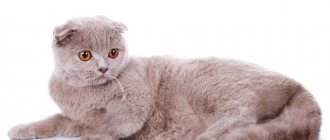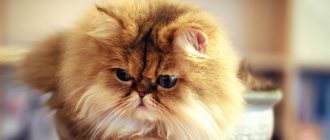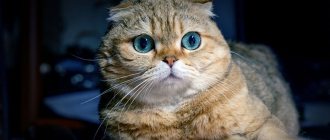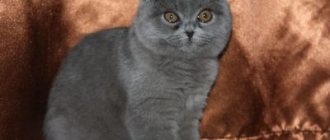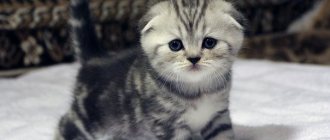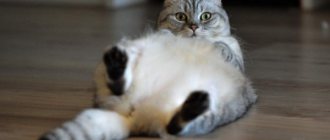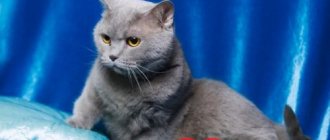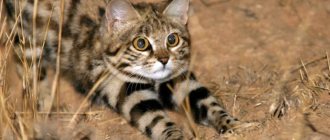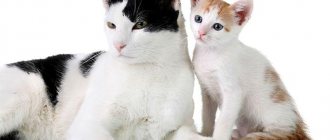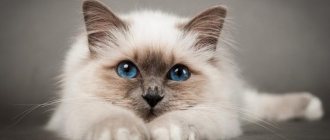9249Administration
1
When purchasing a small kitten for your home, all animal lovers are interested in the question: how long do Scottish fold cats live? The answer to this question cannot be unambiguous, since life expectancy depends on many factors, including living conditions, the health of the pet and hereditary data. With proper care, Scottish cats live on average 15-20 years.
Taking these data into account, it can be argued that they are a kind of long-livers among felines, they have good health and a fairly hardy body. However, like all other breeds, Scots have their weaknesses, which can affect the lifespan of Scottish cats.
These weaknesses include:
- the need for additional nutrition of bone and cartilage tissue, despite a strong skeleton;
- the need for additional ear care is a feature of fold-eared cats;
- the need for constant regulation of the diet due to the tendency to be overweight.
Scottish cats are popular not only for their special ears, but also for their cute facial expression, the main decoration of which is their large, expressive eyes. However, the ears and eyes require special care, since the tear ducts are very easily clogged with dust , given the structure of the ears, they can also become clogged, and cat owners may not notice the appearance of ear mites at all in the absence of proper care. And these factors directly affect how many years Scottish cats live at home.
© shutterstock
How to extend your pet's lifespan
In order to ensure a long life for your cat, you must follow several rules:
- Visit your veterinarian regularly and get all necessary vaccinations;
- diversify your pet’s diet so that he receives a sufficient amount of protein and a small amount of carbohydrates;
- it is necessary to regulate your Scot's weight and growth parameters;
- ensure regular hygiene of ears, teeth and eyes, which will eliminate various types of diseases.
Compliance with these rules can significantly increase the life expectancy of Scottish cats and prevent the occurrence of chronic diseases of the skeletal system, hearing and vision.
Description of the breed
The Scottish Fold is a very kind, calm and balanced breed. Such a cat will not run around the apartment all day long, jump out of the window while hunting birds, or damage furniture and other things in the house. He prefers a quiet lifestyle, but one must understand that there is also a share of activity. If an animal sits locked up all day and does not move, it will die.
Initial examination by the breeder
Before purchasing a kitten, you need to carefully consider its physiological indicators. After all, most diseases in this breed appear with age and are not fatal, but can significantly spoil your joy from purchasing a kitten and affect the length of its stay with you.
Therefore, it is recommended to purchase representatives of this breed at the age of two to three months, when the kitten is already fully formed, eats independently and is strong enough to move to a new place of residence.
It is necessary to pay attention to the quality of the coat, the cleanliness of the tear ducts, as well as the behavior of the kitten, since many diseases, including bone diseases, may not appear immediately. However, their presence can affect the cat's behavior.
“Vulnerable” places of Scottish folds
Scottish Fold is classified as an undemanding strong breed. But every artificial species has “vulnerable” places.
What problems do owners of fold-eared cats encounter?
- Diseases of the musculoskeletal system. In adulthood, problems with the development of bone and cartilage tissue begin.
- Cats easily gain excess weight as a result of a sedentary lifestyle and an unbalanced diet. This gives impetus to liver and heart dysfunction, and the risk of serious problems increases.
- The ear is the weakest point of the Scottish Folds. Responsible owners of fold-eared cats regularly inspect their pets' ears and clean them of dirt and wax. Otherwise, an inflammatory process appears and enters the chronic stage.
- Long-haired cats suffer from the appearance of dense mats due to insufficient coat care. This reduces mobility and negatively affects muscle tissue throughout the body.
Be sure to read:
British Marbled: types and characteristics of color, character and habits, how to breed, care
There are diseases that are most often inherited by Folds.
What diseases do cat owners face:
- Osteochondrodysplasia. Health problems can be identified by lameness and hardening of the tail.
- Osteoarthritis is joint stiffness.
- Hypertrophic cardiomyopathy is a problem with the functioning of the heart.
- Polycystic kidney disease.
Important! If crossed incorrectly, the risk of bone problems increases.
How to make your pet long-lived
At home, fold-eared cats live quite a long time, but this does not mean that a seemingly healthy cat does not need regular veterinary monitoring. After all, the key to a long life is timely vaccination from a veterinarian and maintaining a veterinary passport. And if any disease occurs, you must consult a doctor, as he will be able not only to diagnose it, but also to treat it correctly.
With proper care, a Scottish Fold cat can live up to 20 years, and sometimes more, so your cat's lifespan is entirely in your hands and depends on the quality of your care.
How long do Scottish fold cats live at home?
Each breed has its own biological clock, which counts down the time of approaching old age. It is interesting that this criterion has not yet been deciphered by genetic scientists and the life expectancy of Scottish fold cats is determined only by practical observations.
Experts and professional cat breeders operate at a period of 15 years. During this time, the Scot goes through a full development cycle - from birth and growing up to old age.
Felinologists compared the life expectancy of a Scottish cat with representatives of other breeds. To do this, parallels were drawn with the performance of animals that took part in the selection of the Scottish Fold.
- British short- and longhaired cats. These are the direct ancestors of the Scots, who were separated into a separate breeding group due to a genetic mutation of the ears. The life expectancy of the British reaches 20 years.
- American Shorthair breed. According to one version, British cats came to the islands with the Roman conquerors at the beginning of the last millennium or were later brought by the Crusaders. So the short-haired “Americans” also influenced how long Scottish cats live. The lifespan of these cats is on average 15 years.
The next nuance is the intra-tribal division into fold-eared and straight-eared (straight). This is the same group of cats, only with different manifestations of the set of fd genes, which are responsible for the structure of the auricle.
All Scottish kittens are born with normal ears. At the age of 2-3 weeks, you can already understand which babies appeared in the litter.
- in the fdfd variant, cats are born with normal ears;
- with a combination of Fdfd or FdFd, the tips of the ears are curled.
The presence of diseases of the musculoskeletal system also determines how many years a Scottish cat will live. Fold-eared pets are prone to this pathology due to a gene that deforms the ear cartilage. Therefore, it is believed that straight-eared Scottish cats live longer.
Important! In the absence of genetic abnormalities, straight-eared and lop-eared Scots develop similarly and almost always live to a ripe old age.
How to increase the lifespan of a Scotsman
Thanks to many advances in veterinary medicine and the development of the pet business, the lives of pets have become much longer and more comfortable . To ensure that 15 years is not the limit for the life expectancy of a Scottish Fold, its owner must be responsible, starting with the choice of a kitten and throughout the pet’s life.
- You should only purchase a fold-eared baby from a conscientious, reputable breeder or at a cat show. This solution minimizes the risk of purchasing a sick animal.
- Particular attention should be paid to issues of maintenance and care.
- Even before the furry newcomer appears in the house, you need to decide on the type of food he will eat, whether it will be factory-made food or natural products. When choosing ready-made food, preference is usually given to the “super-premium” and “holistic” classes: these lines take into account the age, breed and individual characteristics of cats.
- A natural diet should be balanced, varied, meeting the needs of carnivores in general and Scottish Folds in particular: contain not only all nutrients, but also taurine, which Scottish cats, like all other cats, do not produce on their own.
Important! The process of digestion and fermentation of food in a cat’s gastrointestinal tract depends on the type of food. Mixing canned and natural products in one serving is unacceptable, as it leads to disorders of the pancreas and intestines.
- Routine and preventive examinations by a veterinarian are required, as well as timely vaccinations against rabies, panleukopenia, chlamydia, calcevirosis, and rhinotracheitis.
- Given the propensity of the Scottish population for cardiomyopathy and the difficulty in diagnosing this disease, ultrasound of the heart and chest should be included in the examination.
- Monitoring the condition of the gums and teeth must be constant: dental problems lead to diseases of the digestive system.
- If breeding a breed is not the purpose of purchasing an animal, it is advisable to sterilize it in due time.
- Regardless of whether the Scottish Fold is outdoors or in contact with other animals, periodic anti-parasitic measures are required.
- To maintain muscle tone and good shape, your pet needs to be provided with physical activity through games and training.
Such careful care and sincere love will allow the Scottish Fold to live to the respectable age of twenty.
Home life
Scottish Folds are definitely family pets. It would be hard for them on the street. Despite their good health, these are rather fragile creatures. They are easily susceptible to infections. Therefore, if the cat is lost, after finding it, you need to take the lost cat to the veterinarian for examination and vaccinations. At home, the cat should not be exposed to stress. Make sure that children do not harm the animal. This breed is very affectionate, so it often comes to cuddle and play. Respond to the love impulses of your pet, this is very important for her. A pleasant atmosphere in the house will relieve the cat from stress, and therefore prolong its life.
Features of keeping a Scottish cat
Kittens of this breed are very smart, active and playful. They quickly get used to the tray and understand the word “no”. These cats become attached to their owner and are even able to sense his mood. They have a calm character and are completely non-aggressive. It has been noticed that Scottish cats are afraid of heights and are very obedient. Therefore, they rarely harm or spoil things. These animals are ideal for homes with small children or older adults. They are undemanding, quickly adapt to new conditions and are easy to care for.
To do this, you need to bathe your pet 1-2 times a month. More often it is not recommended - Scottish cats are very clean. Their claws need to be trimmed the same number of times. Every day you need to wipe your cat's eyes with a damp cloth and comb its fur several times a week. It is also important to properly care for your pet's ears. It is necessary to cut off the regrown hairs from them and regularly inspect them. Due to the fact that the ears are tightly pressed to the animal’s head, wax and various secretions often accumulate in them, and ear mites can develop.
Relationships with other animals and children
Scottish Folds are obedient, non-hyperactive animals. They treat children warmly, play and communicate with them without letting out their claws. They are indifferent to other people's children who come to visit, but they will humbly allow themselves to be touched and stroked.
Scottish Folds do not conflict with other animals, allowing them to dominate.
There are few conflicts with these pets, and they are rarely considered direct initiators of conflicts. Scottish Fold cats are tactful and forgiving, not subject to impulsive reactions. Behavior that goes beyond the boundaries is observed in them extremely rarely, much less often than in representatives of other breeds.
Nutrition
Before you get a furry pet, you need to find out what to feed your Scottish kitten. Animals of this breed have poor health, so it is important to pay a lot of attention to this. You can feed your pet both dry food and natural food. Veterinarians believe that natural food is still better. But you need to make sure that your pet receives all the necessary nutrients. Additionally, you need to purchase vitamins for Scottish cats. They contain special microelements to strengthen the pet’s cartilage tissue and improve the condition of the coat.
A cat's diet should be varied. An adult animal is fed twice a day. The diet should include meat - chicken and beef. You should also give your pet porridge with meat or vegetable broth, stewed and raw vegetables, and egg yolk. It is beneficial for them to eat cottage cheese and other fermented milk products. You also need to buy special grass for cats at the pet store.
If you feed your pet dry food, you need to choose premium food. Only they contain high-quality ingredients and all the necessary vitamins.
